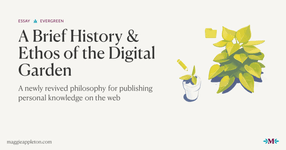Think about the way Wikipedia works when you’re hopping from
Bolshevism to
Celestial Mechanics to
Dunbar’s Number . It’s hyperlinking at it’s best. You get to actively choose which curiosity trail to follow, rather than defaulting to the algorithmically-filtered ephemeral stream. The garden helps us move away from time-bound streams and into...
See more
